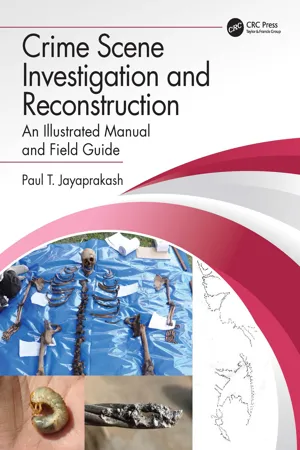
Crime Scene Investigation and Reconstruction
An Illustrated Manual and Field Guide
- 396 pages
- English
- ePUB (mobile friendly)
- Available on iOS & Android
Crime Scene Investigation and Reconstruction
An Illustrated Manual and Field Guide
About This Book
Crime Scene Investigation and Reconstruction: An Illustrated Manual and Field Guide provides methodologies to help investigators to think broadly when seeking out evidence at a scene and, likewise, utilize all the information from a case—especially the observable physical evidence, besides what are collectable, in reconstructing events.
In the introductory chapters the author highlights the importance of crime scene reconstruction when answering the question "How something could have happened?" From there, he goes on to explain the principles of exchange, identification, individualization and reconstruction. Here, the "observe-hypothesize" model, proposed in this field-guide, is presented: outlining how every source of information ranging from laboratory reports, opinions from medical doctors, statements of witnesses, and confessions of suspects should be reconcilable with the evidence-based reconstruction made in the crime scene. In this, the author contends that qualified crime scene generalists are the ideal professionals to frame scientific hypothesis and to make reconstructions. Practical recommendations, based on best-practice general crime scene procedures are provided while the second half of the book illustrate and outline how to deal with various types of major crime scenes, including fire deaths, exhuming buried human remains, sexual assaults, death by electrocution, explosion, drowning, poisoning, hanging, and more.
Since a picture is a worth thousand words, over 400 collective photographs and sketches are included throughout the book to illustrate the observational methods that are described. In addition, the field-guide provides several easy-to-follow flow-charts to serve as checklists to aid scene investigation in major types of crime scene. In this, Crime Scene Investigation and Reconstruction: An Illustrated Manual and Field Guide will help investigators readily recognize similar manifestations in crime scenes and to apply and use such techniques appropriately in their own work.
Frequently asked questions
Table of contents
- Cover
- Half Title
- Title
- Copyright
- Dedication
- Contents
- Preface
- Acknowledgments
- Author Biography
- Chapter 1 Introduction
- Chapter 2 Conceptual Foundations in Forensic Science and the Position of Crime Scene Investigation
- Chapter 3 General Crime Scene Procedure
- Chapter 4 Scheme for Investigating Cases of Death by Hanging
- Chapter 5 Scheme for Investigating Cases of Death due to Traumatic Injuries
- Chapter 6 Scheme for Exhuming Buried Human Remains
- Chapter 7 Scheme for Investigating Cases of Death due to Burns
- Chapter 8 Scheme for Investigating Cases of Death due to Fall From Height
- Chapter 9 Scheme for Investigating Cases of Death due to Electrocution
- Chapter 10 Scheme for Investigating Cases of Death by Drowning
- Chapter 11 Scheme for Investigating Cases of Death due to Poisoning
- Chapter 12 Scheme for Investigating Sexual Assault Cases
- Chapter 13 Scheme for Investigating Cases Involving Firearms
- Chapter 14 Scheme for Investigating Cases of Explosions
- Chapter 15 Scheme for Investigating Structure Fires
- Chapter 16 Scheme for Investigating Vehicle-Related Incident Scenes
- Chapter 17 Epilogue
- Appendix
- Index